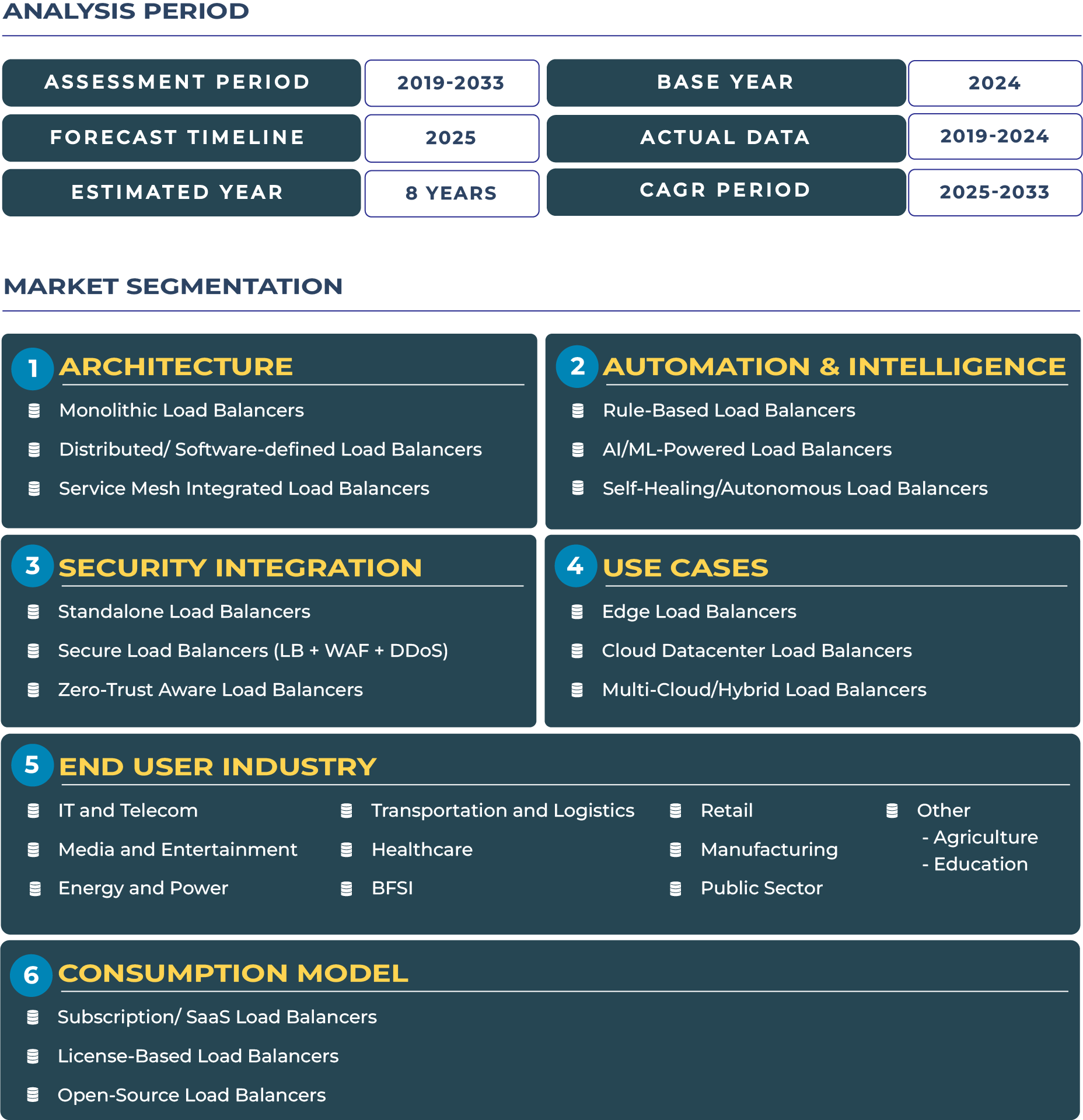Report Format:
![]()
![]() |
Pages: 110+
|
Pages: 110+
Sustainability-Led Cloud Adoption: Market Outlook for Nordics Cloud Load Balancers
The Nordics region—covering Sweden, Norway, Denmark, Finland, and Iceland—has become a global reference point for sustainable cloud adoption. With energy grids powered predominantly by renewable sources and governments actively backing digitization, enterprises in the Nordics are increasingly embedding sustainability into technology infrastructure decisions. Cloud load balancers, critical for ensuring high availability, workload efficiency, and regulatory compliance, are seeing accelerated adoption in this sustainability-first environment. According to DataCube Research, the Nordics Cloud Load Balancers Market is projected to reach USD 92.7 million in 2025 and grow to USD 332.2 million by 2033, registering a CAGR of 17.3%. This performance is underpinned by rising demand for distributed and service mesh integrated load balancers, which optimize workload distribution across multi-cloud environments and enable enterprises to align efficiency with green computing objectives. The region’s reputation as a digital innovation hub, combined with its unique positioning in sustainable data center exports, cements the Nordics’ role in the evolving cloud load balancers ecosystem.
Balancing Growth and Constraints: Drivers & Restraints in the Nordics Cloud Load Balancers Sector
Green data centers as primary accelerators of market growth – The Nordics benefit from an unparalleled abundance of renewable energy resources, such as hydro and wind, which have fueled the growth of Nordic Council’s green digital infrastructure agenda. Enterprises increasingly prioritize carbon-neutral load balancing strategies to align with corporate ESG goals. Service mesh integrated load balancers are particularly in demand to optimize microservices workloads within these green data centers, ensuring efficiency while reinforcing sustainability credentials.
Digital adoption supported by innovation-friendly governance – Government-backed initiatives, such as Finland’s national AI and cloud strategy, and Denmark’s digital growth framework, are further strengthening adoption. Enterprises across healthcare, financial services, and manufacturing are deploying software-defined load balancers to support real-time workloads and multi-cloud orchestration. This state-driven focus on innovation places the Nordics cloud load balancers industry ahead of many European counterparts.
Constraints from regional scale and infrastructure costs – Despite its strong foundations, the Nordics cloud load balancers sector faces challenges. The relatively small population and market size limit large-scale domestic demand, forcing providers to rely on export-driven cloud services. Additionally, the costs of advanced infrastructure—particularly service mesh and distributed load balancing—remain high due to reliance on specialized imports. Such factors create barriers for small and mid-sized enterprises, which may delay scaling adoption compared to larger players.
Emerging Trends and Opportunities Reshaping the Nordics Cloud Load Balancers Landscape
Sustainability-driven demand for green cloud infrastructure – Enterprises are increasingly integrating load balancing solutions that prioritize energy efficiency and carbon-neutral operations. This trend is supported by initiatives like Sweden’s Ministry of Enterprise and Innovation emphasis on climate-smart digitalization. Sustainable cloud load balancers are no longer niche; they are becoming a mainstream demand across sectors such as telecom, healthcare, and BFSI.
Edge computing and IoT workloads expanding adoption – The Nordics are early adopters of IoT in smart cities, autonomous transport, and manufacturing. Load balancers integrated with edge deployments are enabling efficient handling of IoT traffic, particularly in Copenhagen and Helsinki, where 5G-driven ecosystems are evolving rapidly. Distributed load balancers are ensuring low-latency operations critical to these next-generation applications.
Opportunities in AI-driven public sector and export-driven green data centers – National governments are exploring AI-driven workloads in education, healthcare, and governance, which creates significant demand for resilient cloud balancing solutions. Simultaneously, the region is becoming an exporter of green data center capacity to continental Europe, offering new opportunities for cloud load balancer vendors to serve cross-border workloads. This dual dynamic positions the Nordics cloud load balancers landscape as both a domestic growth story and a regional export opportunity.
Competitive Landscape: Building a Sustainable Edge in Nordics Cloud Load Balancers
The Nordics market is shaped by both global hyperscalers and local innovators adapting strategies to sustainability priorities. Microsoft opened a new data center region in Sweden in 2023, aligning with renewable-powered operations and embedding advanced load balancing features for enterprise workloads. Amazon Web Services (AWS) announced its Norway expansion planned for 2024, aiming to capture demand in BFSI and public sector workloads with a focus on sustainable architecture. In parallel, Google Cloud is expanding its green data center capacity in Finland (2024), emphasizing service mesh load balancing that supports distributed SaaS and enterprise workloads. Local Nordic technology providers are complementing these hyperscaler moves by tailoring solutions for healthcare digitization and fintech ecosystems, strengthening the cloud load balancers sector with region-specific expertise.







